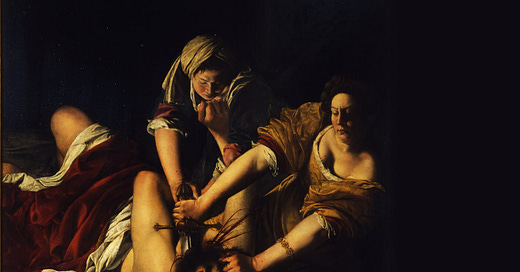It is the festival of lights, celebrating the miracle of a single jar of oil somehow lasting for eight days to illuminate the reclaimed, but defiled, Temple after Judah Maccabee led the Israelites in defeating the Syrian army. That’s pretty much what I knew about Hanukkah and why each day a candle is lit until a menorah holds eight flaming candles, signifying the eight days before the Temple’s supply could be replenished. Because the largest Orthodox Jewish community outside Israel is the next neighborhood over from mine, a menorah is set in the small park where my dog likes to run around thinking he can catch squirrels. While waiting for him to give up in the dusky cold, it is a small, inviting pleasure to watch another of the menorah’s makeshift candles flicker to life against the purple sky.
The prominence of latkes on the Hanukkah table is not so straightforward but a whole lot more dramatic, revolving around a woman, Judith, saving her people from an Assyrian conquest by seducing a general with cheese and wine and then chopping off his head.

My doctor and his staff are Orthodox and his nurse, Ruth, told me all about Judith when I went in for my annual checkup and asked about where latkes fit into the Hanukkah story. She said that, strictly speaking, Judith shouldn’t eclipse Judah. He saved the Temple, after all. But she rather tell Judith’s story and I can understand why.
Ruth is the first person patients see. She sits alone in a back room crowded with instruments. Small, bewigged, eyeglasses too big for her fine-boned face, she’s old enough to have a grown daughter who, unfortunately, is not getting pregnant after four years of marriage. Not that it’s anyone’s fault, she quickly says; they’re just not trying hard enough. It’ll happen when it happens. Ruth’s mother lives with her in the house where she was raised. Every patient knows the saga of caring for her.
“Ninety-three years old,” she says. “She’ll outlive us all.”
She records patients’ vital signs—height, weight, temperature, heart pressure, lung capacity. She performs EKGs. She administers flu shots, taking for permission her advice that everyone needs them. She tells patients they’re beautiful when they don’t feel particularly beautiful. She assures them each day is a blessing.
Ruth knows every little thing about us and always asks how our work is going. My visit coincides with the second day of Hanukkah and after my flu shot I ask her for something else—how does she make her latkes. It’s actually her mother’s recipe, and she says it’s famous. The secret is how you fry the potatoes and always in a good-quality chicken fat or schmaltz.
“If you can’t make it yourself, there’s a store around the corner on McDonald Avenue that I trust. Go there when you’re out of here,” she says.
My doctor butts into the room. ‘What’s taking so long?”
“I’m telling her how to make latkes,” she says.
“You’re in room 3,” he says in his accustomed offhanded agitation, and I thank Ruth for the tip as I follow him out.
My doctor, a funny man I owe my life to, presses his stethoscope to my back, listening to my lungs do their job. One of the ways my doctor is different from any other doctor I’ve every had is that he balances how much he knows of my life with what he reveals about his own. So he’s told me how he met his wife in Paris and that her family is Ashkenazi. Her grandparents perished in a concentration camp, but they managed to save his wife’s mother through the British Kindertransport efforts and was eventually reunited with an aunt who survived the war.
It’s a good guess that his wife’s latkes are different than Ruth’s. The Ashkenazi recipe harkens back to Italian Jews in the Middle Ages. It incorporates a creamy cheese and comes out looking like a pancake. This makes it closer to something that Judith might have served her Assyrian victim. They’re also more dessert-like.
Ruth’s latkes originated after potatoes made their way from the Americas to Europe in the 19th century. Cheap and plentiful, they quickly formed the basis of peasant food. The same goes for chicken fat that was more readily available and less expensive than olive oil.
My doctor proclaims me fit but to watch for his text alerts if another booster is needed. And one other thing—with my high cholesterol, stay away from chicken fat. Try using coconut oil.
“Don’t tell Ruth,” he says as I go one way down the hall and he returns to Ruth’s door to extract his next patient.
Outside, I turn left toward McDonald Avenue, find Ruth’s store, and join a bunch of other women standing in the midst of a crash site of baby carriages. A fine jar of chicken fat now sits in my cabinet, right next to the tub of coconut oil. I used a little of it for the potato recipe, and then substituted coconut oil for the cheese. My picky household taste-tester gobbled them both.
Ruth’s Family Recipe for Hanukkah Latkes Related Exactly How She Told Me
“You want a nice firm baking potato, no eyes. Use one medium-size one for two people, or a big one for each man. Peel it, then grate it on a tea towel. Do the same with a nice onion: Grate it right on top of the potatoes, then wrap the pile up in the towel and bring it to the sink and wring out every last drop of water. Now add it to a bowl with some salt and pepper—some people add other things [she means herbs or spices], but I don’t like that. Add a couple of tablespoons of flour—just enough to make a nice bind. Heat your oil in a big frying pan and drop a soupspoon of potatoes in. Don’t crowd because it’s hard to turn them over. I like them thin and crunchy, so I press the mound down and don’t turn until the bottom’s brown. That depends on you. Flip it over, do the same thing. Take out and drain on a paper bag.”
Cheese Pancakes: The Original Latkes Recipe
This recipe comes from Rabbi Gil Marks by way of The Daily Meal. His history of the food served during Hanukah through the ages is both comprehensive and menu inspiring!
6 ounces farmer cheese, pot cheese, or drained ricotta cheese
4 large eggs
About ¾ cup all-purpose flour
2 tablespoons sugar or honey
½ teaspoon vanilla extract
About ½ teaspoon table salt or 1 teaspoon kosher salt
Vegetable oil or butter, for frying
Sour cream, yogurt, maple syrup, cinnamon-sugar, or fresh fruit, for serving
In a large bowl, beat together the cheese, eggs, flour, sugar, vanilla, and salt until well combined.
In a large skillet or griddle, heat a thin layer of oil or butter over medium heat. In batches, drop the batter 1 heaping tablespoon at a time and fry until the top is set and the bottom is browned slightly, about 3 minutes. Turn and fry until golden, about 2 minutes.
Serve with sour cream, yogurt, maple syrup, cinnamon-sugar, or fresh fruit.



